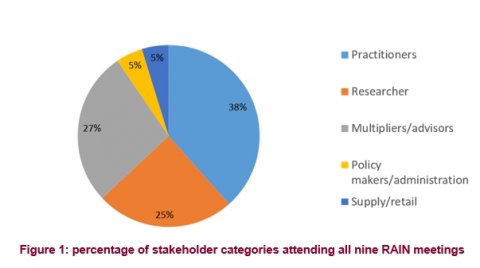
A total of 273 stakeholders, of which 105 farmers, participated in the third RAIN meetings across the AFINET project region. The goal of one third of practitioners participating in the RAINs is with an average representation of 38% fulfilled, similar to the previous RAINs. The average number of participants in each of the nine RAIN was 30 people, with a minimum of 20 and a maximum of 57. All of the individual RAINs were able to more or less maintain their core group of RAIN members. Some additional members were invited in the different RAINs in accordance with the topic the RAIN was focusing on.

Results of the third RAIN meeting
RAIN members were given an overview of all innovations being addressed in the different AFINET regions. During the meeting they (1) validated this list, (2) could express their interest in innovations of other regions, (3) identified synergy regions and (4) gave input for the specific innovations based on their own field of expertise. This process yielded a priority innovation list for each region. Local innovation brokers are now moving on with the production of dissemination materials (fact sheets, tutorial videos, technical articles,...) based on this validated list of specific agroforestry innovations for each region.
Knowledge transfer during third RAIN meeting
Each of the partners combined the third meeting with providing information to the stakeholders through farmer testimonies and inspiring field trips. This is an important return for the engagement of RAIN members in the stakeholder groups and at the same tackles already some of the regional challenges and bottlenecks raised in the previous RAIN meetings. An overview of the field visits can be found in the table below.
Table 1: overview of field visits during third RAIN meetings across AFINET project region
|
Spain |
Cabuxa Natur |
Organic goat farm, 260 goats in a semi extensive farming system. The farm consist of 34 ha of permanent grassland and 16 ha of forest (mainly pine plantations.) |
|
Common land community De Carballo |
The community developed a rotational system with horses and celtic pigs. This community have about 700 ha of land and needed a mobile system in order to achieve an efficient rotational system |
|
|
UK |
Home farm in Nottinghamshire |
Dave Rose has planted 11 000 trees on his harm over the last 7 years. Systems include a silvoarable field with apples and cereal, as well as a newly established edible woodland which is grazed by sheep. |
|
France |
Archimboud Sawmill |
Research carried out by the Archimboud Sawmill engineers has shown that profitable solutions can be found to develop wood gasification for energy production. |
|
Finland |
Kilpiän farm |
A 75 ha organic farm using an alley cropping system that proved to be more resilient to drought compared with other farms without agroforestry and where tree rows are used to reduce soil erosion induced by the slope on the fields. |
|
Portugal |
Herdade dos Lagos |
The visit focused on the silvopastoral carob orchard. Attendees were very interested on the technical aspects of carob harvest, namely the usage of mechanical harvesting. |
|
Italy |
Cupidi Organic Farm |
Claudia Cupidi showed the management of Cupidi farm where chestnut, walnut an olive trees are grazed by laying hens. She has given a lot of advice to the stakeholders about the structural design of the farm and the exploitation of processing by-products for the production of manure, biogas and energy. |
|
Hungary |
Ancient wood pasture |
Wood pasture is an important ancient form of farming in Hungary, but great areas are abandoned. A very important cultural, economic and nature protection mission is to save these lands for shepherding. |
|
Belgium |
Fruit tree orchard of ‘Hof ter Saksen’ |
A guided tour of the fruit orchard (apple, pear, cherries) was organized by Jan van Bogaert and Paul van Laer during which the management in an agroforestry context systems was explained. |
Check this article in a pdf format











